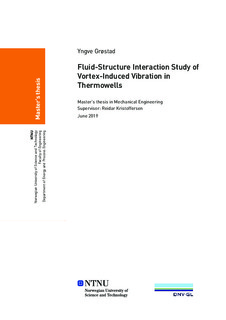Fluid-Structure Interaction Study of Vortex-Induced Vibration in Thermowells
| dc.contributor.advisor | Kristoffersen, Reidar | |
| dc.contributor.author | Grøstad, Yngve | |
| dc.date.accessioned | 2019-10-23T14:00:13Z | |
| dc.date.available | 2019-10-23T14:00:13Z | |
| dc.date.issued | 2019 | |
| dc.identifier.uri | http://hdl.handle.net/11250/2623988 | |
| dc.description.abstract | Termolommer er typisk utsatt for både statiske og dynamiske belastninger grunnet strømningen rundt den. De dynamiske kreftene som kommer fra virvelavløsningen kan bli problematiske dersom de har samme frekvens som egenfrekvensen til termolommen. Når dette hender kan utmatting av materialet og eventuelt sprekkdannelser oppstå på grunn av de høye spenningene. Ettersom plasseringen og størrelsen av disse spenningene er ukjente ønskes en analyse av vibrasjonskarakteristikken og spenningene forårsaket av fluid-struktur interaksjonen av interesse. Denne masteroppgaven presenterer utviklingen av en fluid-struktur interaksjonsmodell for en konisk termolomme under strømningsforhold med et lavt tetthets fluid. Først presenteres de frittstående fluid og struktur systemene før sammenkoblingen introduseres. Resultater for begge de frittstående simuleringene blir presentert for å validere modellene, før resultatene fra FSI simuleringene blir presentert og diskutert. Fluid systemet er modellert i ANSYS Fluent som en 3D transient RANS modell. Strømningens turbulens blir modellert ved bruk av en Realizable k-epsilon turbulens-modell med enhanced wall treatment. Det strukturelle systemet blir modellert i ANSYS Mechanical som en 3D transient modell med dempning. Resultatene fra FSI beregningene viser at en en-veis FSI modell er tilstrekkelig for å simulere vibrasjoner forårsaket av virvelavløsning ved lage tetthetsforhold mellom fluid og struktur. En-veis modellen var i stand til å fange opp kryss-strømningsresonans i termolommen og viser at gode resultater kan oppnåes selv ved bruk av mindre komplekse modeller. Sammenlignet med mer komplekse modeller fra litteraturen ble en reduksjon i kjøretid fra en CPU-tid på 6-8 uker til 6-8 dager oppnådd. Effekten av den koniske geometrien til termolommen med hensyn på resonans ble observert til å være et effektivt mottiltak for å unngå ekstrem resonans av strukturen. Likevel, basert på industrielle standarder viser resultatene at termolommen vil være utsatt for utmatting under resonante forhold. | |
| dc.description.abstract | Thermowells are typically subjected to both static and dynamic forces due to the surrounding flow. The dynamic forces caused by vortex shedding can become problematic if locked-in with the natural frequency of the thermowell. When this happens, fatigue of the material and consequently cracking can occur due to the high stresses. As the location and magnitude of these stresses are unknown, an analysis of the vibratory characteristics and stresses caused by the fluid-structure interaction is therefore of interest. This master's thesis presents the development of a fluid-structure interaction model for the case of a tapered thermowell subjected to a low density fluid flow. Firstly, the standalone fluid- and mechanical systems are presented before the coupling strategy are introduced. Results from both the standalone simulations are presented for model validation purposes before the FSI results are presented. The fluid flow is in the supercritical region and is modelled in ANSYS Fluent as a 3D RANS model using the Realizable k-epsilon turbulence model with enhanced wall treatment. The structure, on the other hand, is modelled using ANSYS Mechanical as a transient 3D damped model. The results from the FSI calculations show that the implementation of a one-way fluid-structure interaction model is adequate when simulating vortex-induced vibrations with low density ratios. The one-way model was able to capture cross-flow resonance of the thermowell and show that good results can be obtained at significantly cheaper computational cost with the use of a relatively cheap turbulence model and a one-way interaction model. Compared to similar studies with more demanding modelling, a reduction in runtime from 6-8 weeks to 6-8 days was obtained. Further, the tapering was found to be an effective way to suppress the resonant response of the structure. However, in resonance, the results conclude that the thermowell will still be exposed to fatigue due to the vibrations based on industrial criterions. | |
| dc.language | eng | |
| dc.publisher | NTNU | |
| dc.title | Fluid-Structure Interaction Study of Vortex-Induced Vibration in Thermowells | |
| dc.type | Master thesis |
